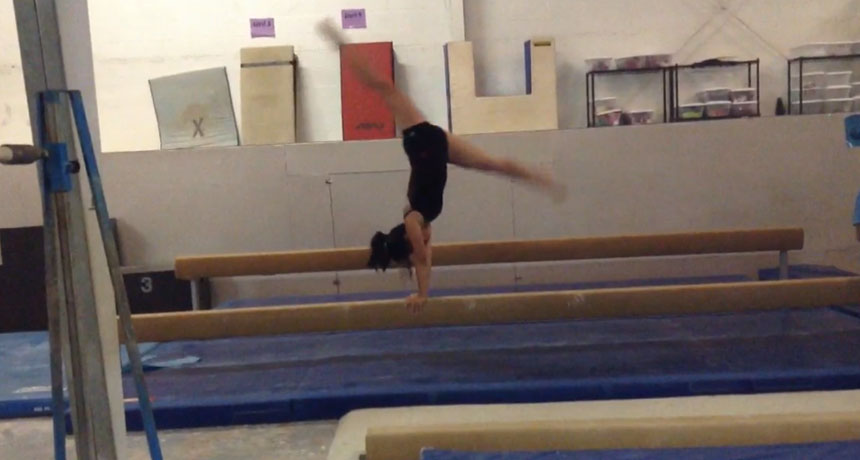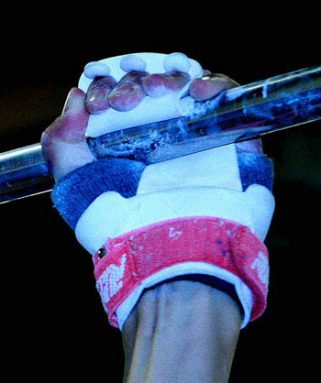Teen gymnast finds how best to keep her grip
A liquid chalk works best when swinging on the uneven bars, a teen finds

Krystle Imamura shows off her gymnastics skills. The teen decided to find out which kind of chalk worked best for keeping her grip.
K. Imamura
PHOENIX, Ariz. — When gymnasts get ready to swing on the uneven or parallel bars, they will usually dust their hands with chalk. The chalk dries their hands and helps prevent slipping. But there’s more than one type of chalk available. Which is best for this use? Krystle Imamura, 18, decided to find out. And when it comes to getting a good grip, she found, liquid chalk outperforms the others.
The senior at Mililani High School in Hawaii showed off her gripping results at the 2016 Intel International Science & Engineering Fair. Created by Society for Science & the Public and sponsored by Intel, this competition brings together more than 1,700 students from around the world to show off their science fair projects. (The Society also publishes Science News for Students and this blog.)
Before Olympians do routines on the balance beam, parallel bars, pommel horse or uneven bars, viewers will often see them reach into a big bowl of white powder. They pat this chalk on their hands. Made of magnesium carbonate (mag-NEEZ-ee-um CAR-bon-ate), it dries any sweat on the gymnast’s hands. With dry hands, these athletes get a better grip.
The chalk comes in several forms, however. It starts as a soft block, which can be used on its own, or crushed into a powder. Companies also sell a liquid chalk, where the mineral is mixed in an alcohol solution. This can be poured on to a gymnast’s hands and then allowed to dry.
“When I was in gymnastics, my favorite event was the bars,” she recalls. Every time she practiced, her teammates would offer advice on which type of chalk to use. Some preferred solid, others powdered.
The teen wasn’t impressed with the advice. “I don’t think it’s the best idea to pick and choose which type is better just hearing it from other people,” she says. She decided to turn to science instead. “I thought it would be interesting if I actually tried to test it, to see scientifically which type is better.”
Solid and powdered chalk were both available at Krystle’s gym. She ordered bottles of liquid chalk online. Then, she and a friend each performed 20 sets of three swings on the uneven bars. Five sets were bare-handed, five used powdered chalk, five used solid chalk and five used liquid. Their goal was to finish the third swing with their bodies in a vertical line above the bar.
“If you have a good grip, you’ll get higher because you’re more comfortable and the shift is easier,” Krystle explains. If one type of chalk worked best, she reasoned, the swings with that chalk should be closer to vertical than swings with other types of chalk.
Krystle made sure that all of the swings were videotaped. She then stopped the videos at the top of every third swing and measured how close to vertical the gymnast’s body had been. She and her friend had the best third swing when using liquid chalk.
Swing and swing again
But one experiment wasn’t enough. Krystle decided to test the swing again. Again, she tested no chalk, solid chalk, powdered chalk and liquid chalk — but not just on her bare hands. She also tested each of the conditions while she was wearing gymnastics grips. These are strips of leather or some other tough fabric that many gymnasts wear when they compete. The grips help the gymnast to, well, grip the bar. “I wanted to make sure I tested [chalk] with the grips because leather is different than skin,” Krystle says. “You want to make sure the chalk affects the leather the same way.”

Krystle found the grips alone made a big difference in how well her swings turned out. But the chalk gave additional grip. And again, the liquid chalk came out on top. Solid chalk came in second, followed by powder. No chalk at all produced the worst swings.
Finally, the teen decided to measure how much friction — or resistance to moving over the bar — each type of chalk caused. High friction would mean less sliding — and a better grip. She cut up an old pair of gymnastics grips into four pieces. One piece got no chalk, one got powdered chalk, one solid chalk and one liquid chalk. She attached each piece to a weight, and dragged the weight across a wooden plank. This made a model — or a simulation — of a gymnast’s hands on the uneven bars. The weight had a probe attached to it, to measure how much force it took to move the weight across the plank. Krystle could use this to measure the coefficient of friction — or how much friction there was between the grip and the plank.
All types of chalk increased friction compared chalk-free grips, she found. But liquid chalk came out on top, followed very closely by solid chalk.
“I was kind of surprised by that,” Krystle says. “I didn’t think the solid would do better than the powder. I personally like the powder better.”
Liquid chalk turned out to have the best results, but Krystle says she didn’t even know what it was until she started her project. “Liquid isn’t common,” she says. Gyms usually give away the solid or powdered chalk for free. She noted that liquid chalk was pretty expensive. That means most gymnasts would probably prefer to use what their gyms provide.
Of course, Krystle is only one gymnast. To really find out which chalk works best, she would need to test many gymnasts. Science takes a lot of time, and some very patient friends. Krystle said it was hard to fit testing into her friend’s schedule. And of course, it takes energy to swing on the uneven bars. Trying to recruit gymnasts after their practice often meant many were too tired to help.
The teen says she worries about bias in her data — when someone in a study has a preference for something being tested. “I was thinking afterward,” she says, that “if some people think the powder works better, they’ll try harder and they’ll think they did better with the powder.”
Now, Krystle has switched to cheerleading just coaches gymnastics. “But if I were competing, I’d definitely go with the solid chalk,” she says, instead of spending extra money on liquid chalk. But now, she has her own research to back up that choice.
Follow Eureka! Lab on Twitter
Power Words
(for more about Power Words, click here)
bias The tendency to hold a particular perspective or preference that favors some thing, some group or some choice. Scientists often “blind” subjects to the details of a test (don’t tell them what it is) so that their biases will not affect the results.
carbonate A group of minerals, including those that make up limestone, which contains carbon and oxygen.
coefficient of friction A ratio that compares the force of friction between an object and the surface it’s resting on and the force of friction that is preventing that object from moving.
dissolve To turn a solid into a liquid and disperse it into that starting liquid. For instance, sugar or salt crystals (solids) will dissolve into water. Now the crystals are gone and the solution is a fully dispersed mix of the liquid form of the sugar or salt in water.
force Some outside influence that can change the motion of a body, hold bodies close to one another, or produce motion or stress in a stationary body.
friction The resistance that one surface or object encounters when moving over or through another material (such as a fluid or a gas). Friction generally causes a heating, which can damage the surface of the materials rubbing against one another.
magnesium A metallic element that is number 12 on the periodic table. It burns with a white light and is the eighth most abundant element in the Earth’s crust.
magnesium carbonate A white solid mineral. Each molecule consists of a magnesium atom linked to a group with one carbon and three oxygen atoms. It is used in fireproofing, cosmetics and toothpaste. Climbers and gymnasts dust magnesium carbonate as a drying agent on their hands to improve their grip.
model A simulation of a real-world event (usually using a computer) that has been developed to predict one or more likely outcomes.
Society for Science and the Public (Society) A nonprofit organization created in 1921 and based in Washington, D.C. Since its founding, the Society has been not only promoting public engagement in scientific research but also the public understanding of science. It created and continues to run three renowned science competitions: The Intel Science Talent Search (begun in 1942), the Intel International Science and Engineering Fair (initially launched in 1950) and Broadcom MASTERS (created in 2010). The Society also publishes award-winning journalism: in Science News (launched in 1922) and Science News for Students (created in 2003). Those magazines also host a series of blogs (including Eureka! Lab).
solution A liquid in which one chemical has been dissolved into another.